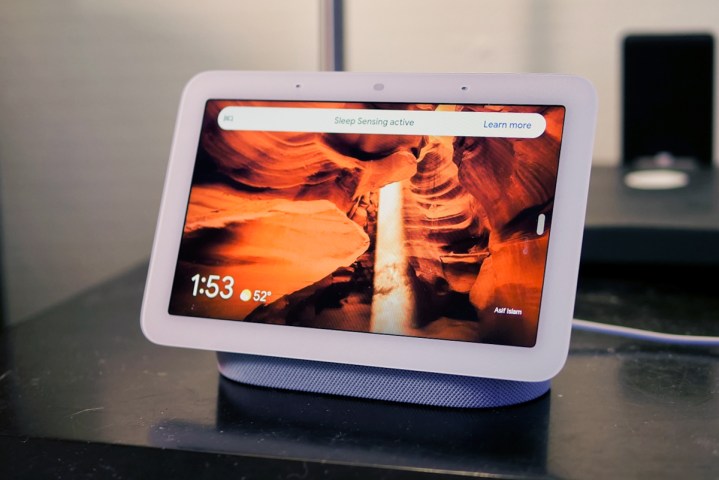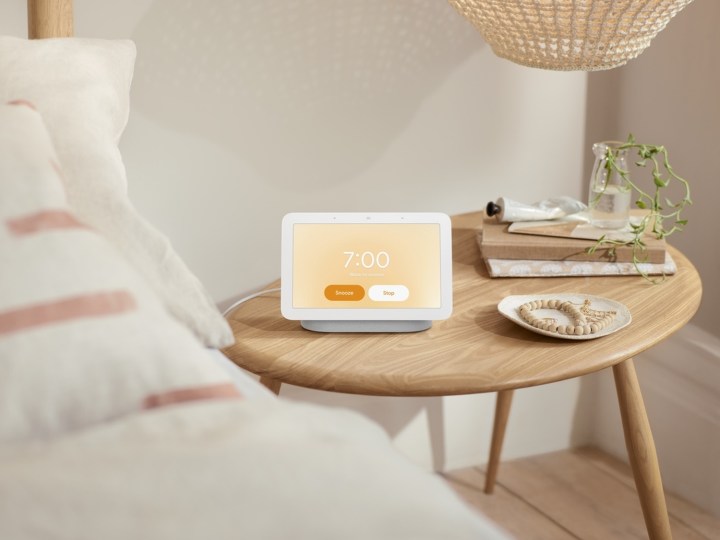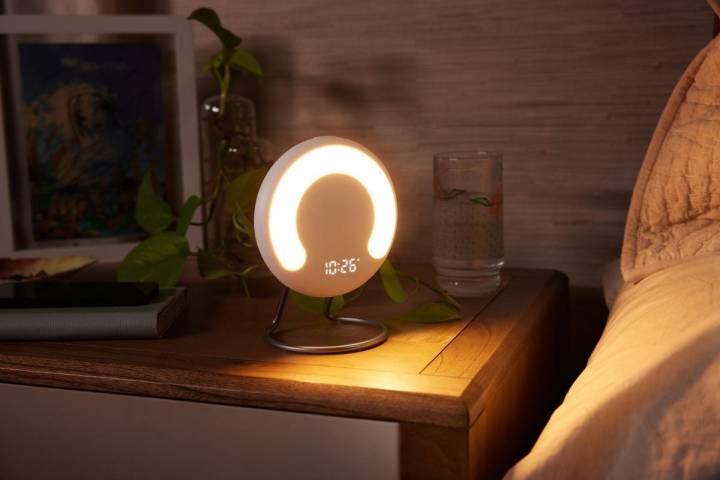Sleep tracking has changed a lot in the past few years. For a long time, the only way to get sleep-tracking info was by placing your smartphone on the bed. Then, smartwatches and fitness trackers brought the technology to our wrists and also added accuracy to the evaluation. But plenty of folks don’t enjoy wearing a device to sleep, so another new generation of sleep-tracking devices is able to offer the same levels of data, information, and insights by placing devices on your nightstand. We’re going to compare the sleep features of two popular smart home devices.
Halo Rise versus Nest Hub 2nd Gen: comparing sleep tracking and features
In this post, we’ll look at a couple of these table-top sleep trackers: The brand new Halo Rise from Amazon and the Google Nest Home Hub Gen 2, which has been around for a year or two.
Design

The Google Nest Home Hub Gen 2 is a small tabletop digital assistant display that has a speaker at its base, with the upper portion being a 7-inch touchscreen. Halo View is a newer device from Amazon, where the top portion is a large plastic oval with an integrated light bar that sits on a small metal base/stand. Halo Rise has no screen and only shows you the digital time; there are no other visible metrics available on the device. The Nest Home Hub looks like more of a purpose-built device, while the Halo View seems a little more utilitarian.
When it comes to which device wins on looks, you can take your pick, but in our opinion, the Nest Home Hub looks like a more professional and versatile contraption, while the Halo Rise, minimalist as it is, looks a bit more like something you’d find in a San Francisco startup’s basement. Halo Rise also seems a bit tippy, but we’ll reserve judgment on that until we can go hands-on with it.
Winner: Nest Home Hub
Digital assistant
Amazon Halo Rise can be paired with Amazon’s Alexa digital assistant to provide an audible summary of your sleeping patterns and the ability to wake up to music rather than the Rise’s alarm tone. You can also add the Rise to a routine to have Alexa turn things on or off when you get into bed. The trouble is, there is no built-in Alexa with this device. If you want to talk to your digital assistant, you actually need another Alexa-enabled device like an Echo Dot. Perhaps this is for privacy reasons, but it seems a bit absurd that you need to pair this device with another Amazon device to get any kind of smart-home integration.
The Nest Hub has Google Assistant built-in, and not only can you ask it for help setting and shutting off alarms and sleep tracking, but you can also use it to enact bedtime and wake-up Routines just by asking.
Winner: When it comes to which device will be more valuable for those who are looking for smart-home integration, the Nest Hub is the winner, hands-down.
Sleep-tracking technology

Amazon’s Halo Rise tracks your body movement and breathing patterns while you sleep. It doesn’t have a microphone but instead uses low-energy radar to track breathing. The Halo Rise should be placed at the side of your bed so that it faces your upper body while you sleep, and it also needs to be at the same height or up to 8 inches above your mattress, so factor that in when you’re making a decision.
The Nest Hub uses motion and sound tracking via a built-in microphone to track and monitor your sleep. It can detect the sounds of snoring or coughing — things that can contribute to broken sleep cycles.
The Nest Hub 2 doesn’t require precise positioning since it uses its microphone to sense sound. The motion detection is a “low energy motion sensor,” which could also be radar tracking, but Google doesn’t specify that the device needs to point at the user.
Either way, neither of these devices utilizes a camera, which is a good thing since a lot of people are suspicious of having a camera in the room where we do some of our most intimate activities.
Winner: Tie
Alarm options and types
The sounds we wake up to are always personal. One person may need the harsh screech of a shocking-sounding alarm, while that kind of wakeup could ruin a more sensitive person’s whole day. Even so, some users prefer waking to audio, while others find waking to light is a more natural and effective way to be roused.
The Halo Rise has an audible alarm as well as a built-in wake-up light that gradually changes color and then intensifies to help you wake up. (It can also use the light feature to simulate sunset to trick your body into falling asleep. Its Smart Alarm system tracks your sleeping stages to find the right time to wake you within the window of time you choose.
The Nest Hub has the advantage of being a full-fledged Voice Assistant, providing audio alarms, either music or tones, and turning the display screen up slowly to simulate the sun rising.
Winner: Google Nest Hub. Whichever way you prefer to wake up, you’ve got choices with both of these devices, but being able to talk to your Nest Hub to snooze or turn off an alarm and then enact a good morning routine gives it a leg up.
Metrics and data
The Halo Rise measures room temperature and the amount of light and humidity in the room. It will provide you with a “sleep score” and tell you how long you spent in each stage of sleep. All of this info can be viewed on your smartphone.
The Nest Hub will track the room’s temperature, the light level, and the amount they change. It also tracks how often you cough, snore, and your general breathing rate. That data can be added to Google Fit as part of your general health monitoring, and it can also be viewed on the display screen.
Winner: Google Nest Hub
Privacy

The Halo Rise has neither a camera nor a microphone, and users can delete the info that Halo tracks. By visiting Settings > Health data in the app, you can download or delete your Halo health data.
The Nest Hub 2 has a microphone but no camera. Some users may be uncomfortable with a microphone close to their bed, but users can review and delete all the data the Hub gathers.
Both Amazon and Google are attempting to be quite transparent about the data they collect and how you can review and delete it.
Winner: Tie
Cost to use
Both of these devices will have a cost beyond the initial purchase price. Halo Rise comes with a six-month membership; then, you’ll have to pay $3.99 per month for a membership to access your metrics.
Google is offering Sleep Sensing for free throughout 2022. In 2023, they plan to integrate the technology into Fitbit Premium at the cost of $12.99 a month or $104.99 per year, subject to change, and price and availability may vary by country.
Winner: Halo Rise, simply because it costs less upfront, and a lot of people will appreciate the savings.
Overall winner
Both of these devices offer similar features and can add metrics to your smart-home setup, though you’ll need to have an Amazon Alexa hub device to use the Halo Rise to its full potential. The subscription cost seems like an unnecessary annoyance. While the Nest Hub 2 ($100) is cheaper than both the Halo Rise ($140) and an Alexa device (the Echo Dot 5th-generation is $60), the higher monthly fee makes the Halo Rise the more affordable option.
In our opinion, the Google Nest Home Hub is a more complete, versatile, and useful device that lets you interact with it on-screen or on a smartphone. Even so, technophobes might prefer the pared-back simplicity of the Halo Rise. For our money, if you’re looking for serious sleep tracking, we pick the Google Nest Home Hub 2nd Gen.




